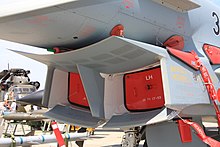

A splitter plate is a component in some jet aircraft, used to control the airflow into the engine. Where the engine air intake is mounted partway back along the fuselage or under the wing, the splitter plate diverts the boundary layer away from the engine intake. It is a form of boundary layer control.
When a body, such as a wing or a fuselage, passes through a fluid such as the air, a boundary layer of fluid attaches to the body and moves along with it. If this layer enters the air intake of a jet engine, it can affect performance.
In order to stop this boundary layer problem from happening, a splitter plate may be used to separate the boundary layer from the fast-moving free airflow and divert it away from the engine intake.
Many splitter plates have a series of holes drilled into the surface closer to the engine side of the intake.[1] Suction is applied to these holes, further reducing the boundary layer.[citation needed]